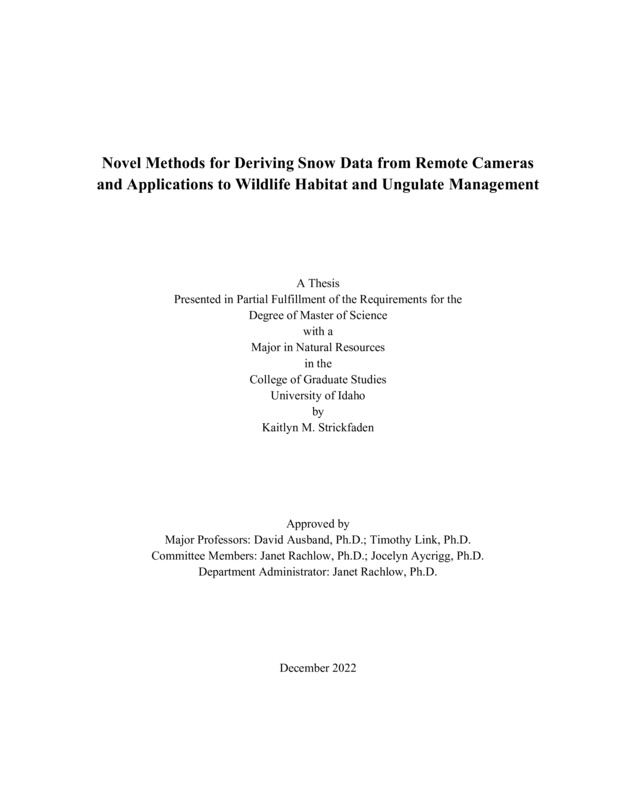Novel Methods for Deriving Snow Data from Remote Cameras and Applications to Wildlife Habitat and Ungulate Management
Strickfaden, Kaitlyn M.. (2022-12). Novel Methods for Deriving Snow Data from Remote Cameras and Applications to Wildlife Habitat and Ungulate Management. Theses and Dissertations Collection, University of Idaho Library Digital Collections. https://www.lib.uidaho.edu/digital/etd/items/strickfaden_idaho_0089n_12472.html
- Title:
- Novel Methods for Deriving Snow Data from Remote Cameras and Applications to Wildlife Habitat and Ungulate Management
- Author:
- Strickfaden, Kaitlyn M.
- ORCID:
- 0000-0002-2760-028X
- Date:
- 2022-12
- Keywords:
- deer habitat management remote camera snow ungulate wildlife conservation
- Program:
- Fish & Wildlife Sciences
- Subject Category:
- Wildlife management; Wildlife conservation; Ecology
- Abstract:
-
Snow, in both its quantity and its dynamics, is a key driver of many geophysical and ecological processes and is well understood from a purely hydrologic perspective. However, snow as it affects wildlife habitat and survival is only understood very broadly despite its potential effects on thermoregulation, movement, foraging, and escape from predation over winter. This knowledge gap can largely be attributed to the lack of snow data at temporal and spatial scales meaningful to wildlife. Remote cameras are already widely used in wildlife research and potentially are a low-cost, low-maintenance option for collecting snow data at high spatial and temporal resolutions in complex forested terrain. My thesis explores how remote cameras can be used to collect snow and weather data and then applies these data to two wildlife habitat questions. I begin by asking what hydrometeorological data can be derived from remote camera images. Chapter 1A focuses on snow depth and a package I built in program R to measure snow depth without the use of permanent snow stakes deployed in the camera viewshed. The potential use of this code in distance sampling with remote cameras is heavily emphasized because it may be of interest to other users of the package. However, for this thesis, no distance sampling was performed; the code was only implemented in creating virtual snow stakes which could be used to measure snow depth in the camera images for Chapters 2 and 3. This R package provides a means for other camera studies to collect fine-scale snow depth data without potentially impacting wildlife behavior. Chapter 1B focuses on correcting air temperature measurements made by cameras and deriving precipitation phase from combined image data and temperature data. The temperature correction model gives researchers more confidence in the temperature measurements collected by their cameras. However, precipitation phase is complicated to discern because of the relatively low resolution of images and the effects of wind and canopy interception. My other two chapters use these methods and models to address two wildlife habitat questions. One, what biophysical conditions promote retention of snow in complex forested terrain? Using snow and temperature data derived from the remote cameras and biophysical data collected at the camera sites, I built a model predicting locations of snow refugia in complex forested terrains. Knowledge about late-season snow cover provides insight into how forests can be managed to promote snow retention and thus promote habitat for snow-dependent wildlife species. Two, how do snow characteristics and winter severity affect the movement and distribution of ungulates over winter? I built a model relating deer and elk detections at my cameras to snow depth and temperature from cameras and snow density and hardness from on-site measurements. Snow density and hardness are expected to change drastically to the possible detriment of ungulates, but these properties are not included in current winter severity indices; My model is the first attempt at including these snow properties to better define winter severity for ungulates in a changing climate.
- Description:
- masters, M.S., Fish & Wildlife Sciences -- University of Idaho - College of Graduate Studies, 2022-12
- Major Professor:
- Ausband, David E; Link, Timothy E
- Committee:
- Aycrigg, Jocelyn L; Rachlow, Janet L
- Defense Date:
- 2022-12
- Identifier:
- Strickfaden_idaho_0089N_12472
- Type:
- Text
- Format Original:
- Format:
- application/pdf
- Rights:
- In Copyright - Educational Use Permitted. For more information, please contact University of Idaho Library Special Collections and Archives Department at libspec@uidaho.edu.
- Standardized Rights:
- http://rightsstatements.org/vocab/InC-EDU/1.0/

